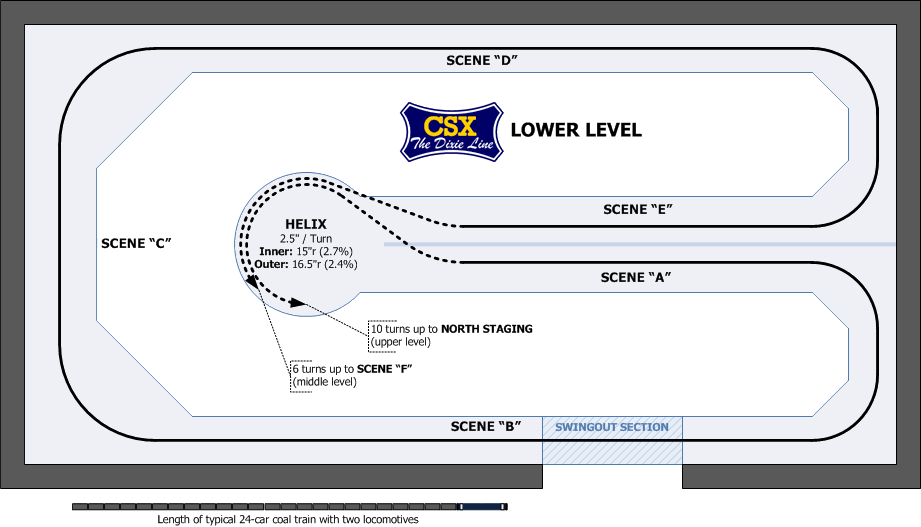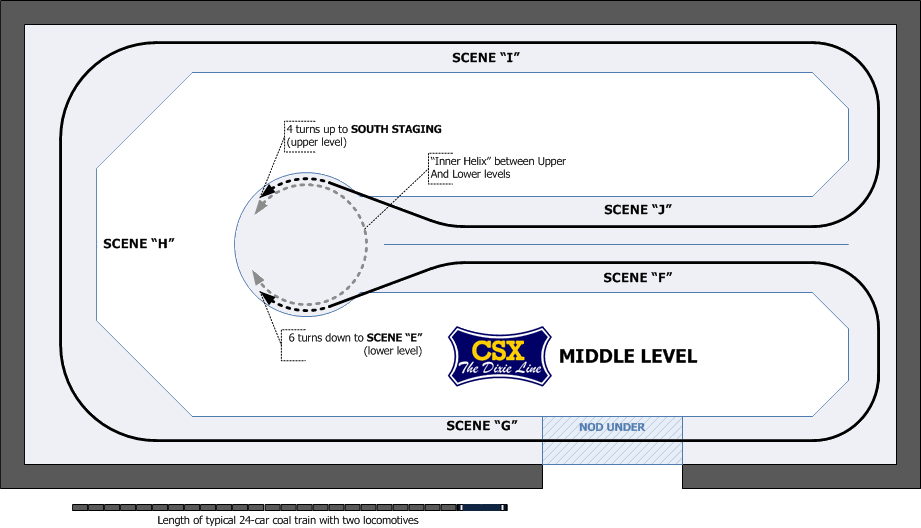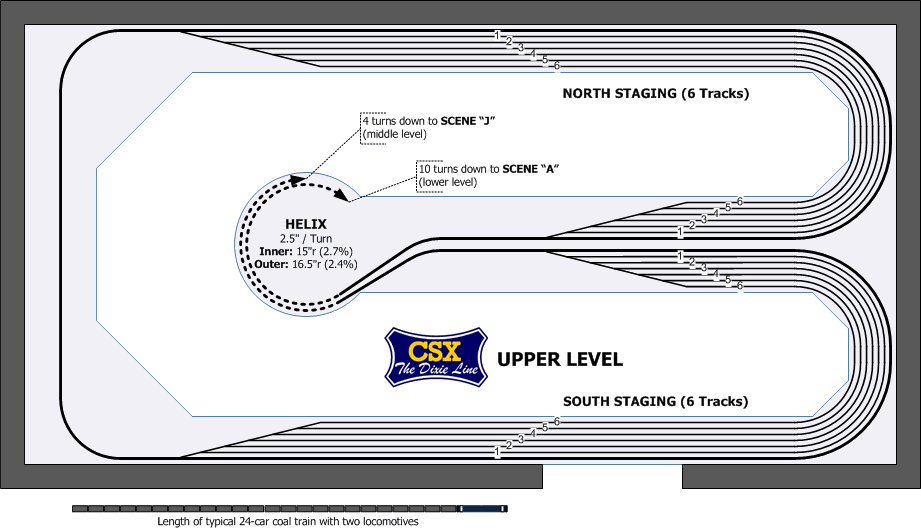You will also notice that there are no specific towns or stations on the track plan at this time. Instead, I have roughed in several locations for "scenes" which will eventually be replaced by towns, stations and industries once I have settled on the specific section of the prototype I will model. As it is, I have placed five potential scenes on each level along the straightaways. This provides for 10 individual scenes, which have been labelled using the letters "A" through "J." If you follow a southbound train out of the north staging yard, you will traverse the layout in alphabetical order starting with scene "A" and ending with scene "J" before ending up in the south staging yard. As the plan evolves, I will begin replacing these lettered scenes with the names of the actual locations to be modeled.
Track Plan at a Glance
Name: CSX Dixie Line
Scale: N (1:160)
Size: 18'-2" x 9'-2"
Prototype: CSX from Atlanta to Nashville via Chattanooga
Period: Modern
Style: Multi-deck, around the walls with peninsula
Mainline run: 132 feet (not including staging or helix)
Minimum radius: 15"
Minimum turnout: no. 10 on mainline, no. 5 branch & staging
Maximum grade: 2.7 percent in helix
Pros
- Layout fits into one room This satisfies the primary political restriction imposed on the layout. Negotiations for right-of-way into other rooms can be deferred until necessary.
- Long length of mainline run Despite the single room restriction, the multiple deck design allows for 132 feet of mainline track, or roughly four scale miles (two miles per deck). This comes out to about 66 feet of track per deck and when you factor in a maximum train length of around 10 feet, it means each deck can have about six blocks. This will allow room for two passing sidings plus four other blocks, with a goal of having two blocks between the passing sidings.
- Plenty of staging There are two staging yards on the upper deck of the layout (north and south) that represent the unseen points beyond the "end" of the visible track. Both staging yards have six double ended tracks that have enough length to hold the longest trains that will run on the layout. In fact, the longest tracks have the ability to hold more than one train to allow for serialized staging if desired. There is also ample space to lengthen one of the staging yards as needed.
- Hidden staging above the layout I originally had this feature in the "cons" section below, but upon further review I have decided this is most definitely a "pro." By placing the staging on top of the layout, I feel I am taking advantage of the fact that this space is readily available on top of the valance for the middle deck and also that a simple extension of the helix allows this space to be reached fairly easily. I plan on having the staging yard "accessible" via the use video cameras and monitors, although time will tell if this feature actually comes to fruition or is simply pie in the sky. In lieu of cameras and monitors, the old reliable combination of mirrors and step ladders should do just fine in providing access to the staging yards.
- Directional continuity On this track plan north is always to the left and south is always to the right no matter which part of the layout is being viewed. This means engineers following their trains will not be confronted with confusing reversals of direction along their route.
- Continuous running A northbound train exiting the layout on the north end will eventually re-enter the layout on the south end, and vice-versa for northbound trains. I believe this is a very important feature when planning a layout that could be operated by a single operator, since you can put one (or more depending on how lucky you feel!) trains into motion in one direction and let them orbit the layout while the operator runs his train in the opposite direction and tries to keep out of the path of the oncoming traffic. This will also be a useful feature when showing the layout to others.
- Build in phases Another important feature of the multi-deck arrangement is that the layout can be built in phases, allowing me to build as little or as much layout as time and resources allow. For example, the first phase to be built will be the lower level. When this is done, only a small portion of the helix will need to be built to function as a return loop at the end of the peninsula. I can then move on to the middle deck and eventually the top staging deck, expanding the helix as necessary as I go.
Cons
- The insatiable appetite of the helix Each turn of the helix gains 2.5 inches of elevation and takes about eight feet of track. There are 6 turns of the helix between the lower and middle decks and 4 turns between the middle and upper decks. This means that a train traversing the entire helix from the lower deck to the upper (staging) deck will require 10 turns, which is about 80 feet of track, which is about 2 1/2 scale miles! However, I feel this part of the design is a necessary evil and is a acceptable trade off for many of the advantages that this track plan offers. Additionally, there are several well known layouts that successfully employ a similar helix strategy. By placing the helix at the end of the peninsula, I have also provided ready access to the helix from outside or inside. The helix will be hidden from view by use of either a curtain or a removable hardboard fascia.
- Narrow aisles The track plan as designed uses a standard aisle width of 30", which is about 6 inches narrower than what is preferred. However, since the layout is planned for only one or two operators, this should not pose much of a problem. It is also the widest aisles I could accommodate while still allowing for the peninsula in the middle of the room. Controls will be minimized along the layout fascia to reduce the risk of operators getting snagged on switches and indicators.
- Long, straight scenes While this may be preferred for Midwest Granger layouts, it is going to be tricky to represent a twisting route through the Appalachians on a shelf that in some places is one foot wide by 18 feet long! However, I believe I can mitigate this by keeping straight track to a minimum and using abundant view blocks to trick the eye into not seeing a straight line. I also plan to keep as much curved track out in the open while any hidden track (such as in tunnels) is on tangent sections.






